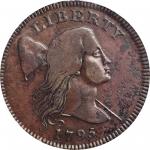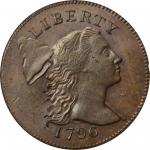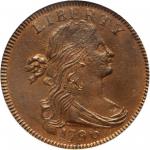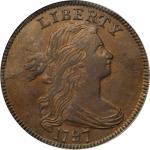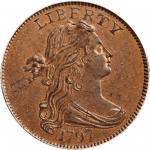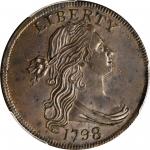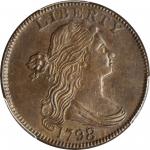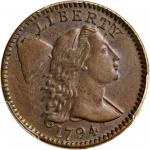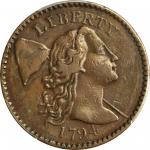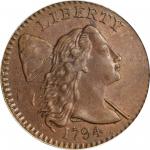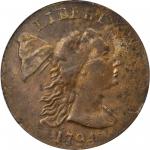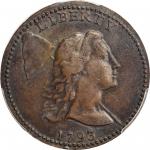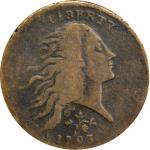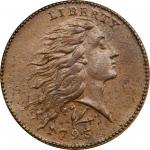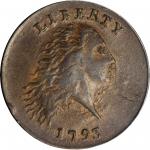1795 Liberty Cap Cent. S-80. Rarity-5+. Jefferson Head, Plain Edge. VF-20 (PCGS).<strong>Type:</strong> Liberty Cap.<p><strong>Design:</strong> Obv: A head of Liberty faces right, the word LIBERTY above, the date 1795 below, and a liberty cap and pole behind the portrait. Libertys hair is combed out almost straight, and there is no hair ribbon. Rev: A wreath of long, lanceolate leaves surrounds the denomination ONE CENT, the base of the wreath bound by a ribbon tied into a bow with three loops. The legend UNITED STATES OF AMERICA is around the border and another expression of the denomination 1/100 is below.<p><strong>Weight:</strong> Per Walter Breen in his 2000 large cent encyclopedia, "the weight range of struck pieces is about 200 to 206.5 grains (13.0 to 13.38 grams)."<p><strong>Diameter:</strong> Approximately 29 mm.<p><strong>Die Variety:</strong> Sheldon-80, Breen-11b. Obv: The Jefferson Head, readily identifiable by the lack of hair ribbon with the individual strands combed out almost straight. This obverse is also used for the 1795 NC-1 and NC-4 varieties. Rev: Also readily identifiable, in this case by the long lanceolate leaves that make this wreath unlike any other in the Liberty Cap cent series. On this particular die, the ribbon ends are long and extend well below the short fraction bar, there is only one berry on a short stem below the letter I in UNITED, there are double leaf clusters below the letters ST and AT in STATES, and the right stem end of the branch is under the right foot of the letter A in AMERICA. This reverse also appears in the 1795 NC-4 pairing.<p>Sheldon-80 is the only die marriage that corresponds to the Jefferson Head, Plain Edge <em>Guide Book</em> variety of the 1795 Liberty Cap cent.<p><strong>Die State:</strong> Noyes B/A, Breen I. Obv: Die lapping has weakened the ends of the hair strands, with the letters in LIBERTY and the digits in the date also thinner. Rev: Perfect.<p><strong>Edge:</strong> Plain.<p><strong>Mintage:</strong> Unknown.<p><strong>Estimated Surviving Population for the Die Variety:</strong> Rarity-5+: Slightly more than 30 examples are known in all grades.<p><strong>Strike:</strong> The elements of the design are very well delineated, particularly so on the obverse where the majority of the hair strands are sharply divided, other than at the highest points of the relief. The date and legend are sharp. The reverse is likewise sharp with all major design elements fully appreciable.<p><strong>Surfaces</strong>: Deep chocolate brown, the surfaces exhibit even, moderate granularity on both sides, while traces of hard, inactive verdigris are seen on the reverse upon close examination. Small rim imperfections are noted on the obverse at 10 oclock, 3 oclock and 6:30; they are not particularly distracting, but will serve to identify this piece in the future. The eye appeal is superior to what one might expect from the surface description.<p><strong>Commentary: </strong>Certainly one of the most interesting and rarest issues of the early copper series is the famous Jefferson Head cent, a name that has persisted, although any resemblance to the third president of the United States seems to be slight. This variety was coined outside the United States Mint by John Harper in an attempt to win a private coining contract. Harpers name is well known to numismatists, as his humble saw shop (sometimes mistakenly called a "cellar") is thought to have been the facility where the first 1792 half dismes were struck, standing in for the still-unfinished United States Mint building nearby. Harpers shop, where this coin was struck, was on the northeast corner of North 6th and Cherry streets, a stones throw from President Washingtons house at 5th and Market and within sight of Independence Hall; the site is now occupied by the National Constitution Center. The First Philadelphia Mint was a little over a block away on 7th Street. Harpers proximity and skill set made him a natural partner for the Mint, and he turns up several times in the Mints account books: providing a press and mechanical assistance in 1792, selling saws in 1793, and selling a pair of rollers in 1794. Harpers talents as a blacksmith and machinist were well known to the Mint when Elias Boudinot, then a congressman, sought advice from Mint assayer Albion Cox on how to improve the Mints processes and production. Cox took "the liberty of recommending to you a practical man who operated in the New Jersey coppers -- he will give you such information with respect to the proceedings of coinage as will appear almost incredible when contrasted with the present proceedings." Assuming that Boudinot, then in the midst of an inquisition into the Mints operations on behalf of Congress, must "be acquainted with the defects" of that institution, Cox strongly recommended he talk to "John Harper, now very extensively in the saw-making business near the iron works at Trenton." According to Pete Smith, Joel J. Orosz, and Leonard Augsburger in the book <em>1792: Birth of a Nations Coinage</em>, Harper "visited the Mint on January 23, 1795, and suggested improvements but [Director David] Rittenhouse and the staff of the Mint were not impressed." Rittenhouse resigned the following June, followed in the directors office by Henry deSaussure, who lasted until just October. The next Mint director was Elias Boudinot, who had been hearing about Harper for nearly a year by that point.<p>Harper reached out to Boudinot almost immediately after his appointment. He wrote on November 4, 1795:<p><em>"I propose to engage with you...to receive sheet copper of the right size and coin the same into cents complete for circulation at the rate of eighty dollars per ton and to return the same in Cents and shruf deducting twenty-five pounds in each ton for waste. I will also forge and harden all the dies, beds, and punches for the same."</em><p>Recognizing that promises and actions are two different things, Harper showed Boudinot what he could do. He made dies and struck the coins that we today call Jefferson Head cents. Elias Boudinot dutifully reported to Congress on Harpers work on February 3, 1796. He told the House of Representatives that Harper had "with great candor and freedom communicated his knowledge" but, having felt a cold reception by the current staff at the Mint during his interaction with them, decided to "make a press and cutting machine at his own expense." A few weeks later, according to Smith et al.:<p><em>"Without Congressional authority, Harper produced dies, built a press, and invited the committee [of the House of Representatives] to observe his ability to produce cents faster and more efficiently than the Mint. The committee was impressed and dug into their own pockets to reimburse Harper for the copper used. Perhaps they took home a few of his cents as mementos."</em><p><em></em>It made Boudinot nervous that Harper had dies that looked so much like federal cents, so he informed Congress that when he "found the dies used by the memorialist [Harper] still in his possession and conceiving this to be very improper [he] took them into the Mint." When he realized that he had no power to reimburse Harper for the dies or his other labors, Boudinot offered him a job as assistant coiner. Harper declined.<p>Within 70 years, Harpers cents were valuable collectibles. The earliest acknowledgement of the desirability of the "Jefferson Head" cents appears in W. Elliot Woodwards sale of October 1864, where lot 617 was described as, "1795 Sometimes called the Jefferson Head, in rather poor condition but an extremely rare type." William Strobridge, a coin dealer then based in New York, bought it for one dollar. It is unknown when this variety was first identified as distinctive, or given the name "Jefferson Head," or by whom. The earliest reference of which we are aware is Edward Cogans sale of June 1864, where one was listed under the heading of "Fabrications," along with things like Bolen copies and pieces with altered dates. Described as "1795 Cent, Jefferson Head," it sold for a quarter. If Cogan could simply call it a "Jefferson Head" and assume bidders would know what it was, and Woodward could use the same name just a few months later, the moniker must have had general currency among numismatists by then.<p>By the 20th century, the Jefferson Head cent was revered as a distinctive rarity in the early copper series. Initially dismissed as a counterfeit intended for circulation, Walter Breen appears to have been the first to make the connection between these cents and John Harpers experiment, leading modern collectors to appreciate these coins as not only rarities, but historical relics of the Mints unsteady infancy. Nearly all surviving specimens are heavily circulated, and many are impaired. Three varieties are known: Sheldon-80, as here, with a plain edge; 1795 NC-1, with a different reverse die and a lettered edge; and 1795 NC-4, from the same dies as Sheldon-80 but with a lettered edge. Among the three varieties, not a single example exceeds Very Fine by EAC grading standards, and survivors are highly prized regardless of level of preservation.<p>The present coin is listed in the Bland census, as published in Walter Breens <em>Encyclopedia of Early United States Cents </em>(2000), as "Fine-15, Sharpness of VF-35." As for sharpness, we agree completely, ranking this coin among the sharpest examples of this very elusive variety. While the surfaces do exhibit the aforementioned granularity, the coin compares nicely with other examples listed in the same reference at higher grades. Further, it seems typical of the variety to have surface imperfections -- genuinely problem-free examples are extremely rare, if not prohibitively so. The example listed at the top of the Bland census as "VF-35, Sharpness of EF-45" (plated in the book) is burnished, scratched and gouged. It is also a resident of the ANS Collection, and is unlikely to ever be available to collectors. The second finest example, ranked as "VF-25, Sharpness of VF-35," has "heavy scratches;" a coin held by the Carnegie Institute and also unavailable to collectors. The third, listed as "VF-20" and the finest in private hands, is actually ranked CC#2 (i.e. ahead of the Carnegie Institute specimen) in the 2007 Noyes census. Certified EF-40 by PCGS, and approved by CAC, that coin most recently appeared as lot 4319 in Heritages January 2019 sale of the Alan V. Weinberg Collection, Part I, where it realized $264,000. Six more pieces, including this one, are described as having sharpness grades in the VF range, all net-graded for various problems common to early coppers, conditions mostly accepted by collectors as part of the nature of this fascinating series. The present example appears in the Bland census as tied for CC#5, but where sharpness alone is concerned it would have perhaps only one or two superiors.<p>To our eyes this coin is somewhat sharper than the one we (Stacks) sold in January 2009, a coin graded Fine-15 by PCGS, with "light even porosity…seen over both sides." That piece sold for $149,500. The Goldbergs sold an example with substantially less detail than the present one (graded VF-20 by PCGS) in September 2009 for $94,875. That coin was microporous and had prominent scratches through the hair. More recently, the Garrett Specimen (graded VF-25 by NGC) was sold by Heritage in March 2012 for $184,000. That piece also exhibited microgranularity and offered less detail than the present coin. Clearly the example we offer here is superb among the few that survive, and it is undoubtedly destined for an advanced cabinet of coppers. It was discovered in Pennsylvania 25 years ago and held by the finder until it made its first public appearance in our August 2012 Philadelphia ANA Auction. It will once again be a prime attraction when it crosses the block as part of the ESM Collection.PCGS# 1386.PCGS Population: 3; 4 finer (EF-40 finest).From the ESM Collection. Earlier ex Jerry Cavalier, unearthed with a metal detector; our Philadelphia ANA Auction of August 2012, lot 11187; Heritages FUN Signature Auction of January 2013, lot 5523; Heritages Chicago ANA Signature Auction of August 2014, lot 5525.

